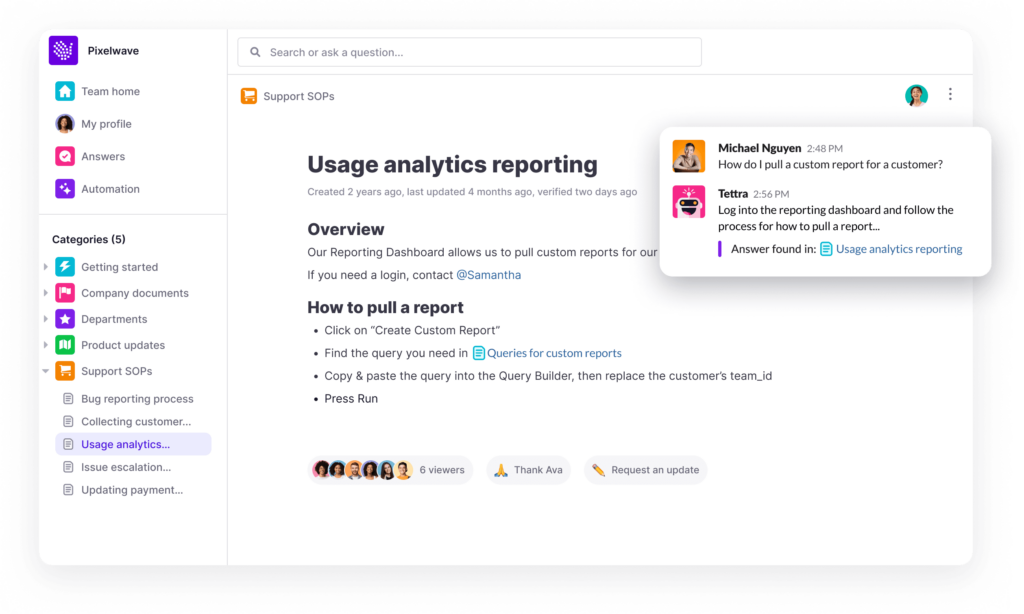What is an internal knowledge base?
An internal knowledge base (or internal KB) is the single source of truth for your team members to reference the information they need.
For example, an internal knowledge base works well for customer-facing teams to find answers they need without repeatedly asking the team lead, director or knowledge base manager.
Your customer support, service or success team can get more efficient and correct answers in a short period of time.
It can become useful in ensuring that all practical knowledge and processes are properly stored and accessible for the benefit of employees and the organization as a whole.
An internal knowledge base gathers all institutional knowledge and practices in one convenient location that can be easily accessed and shared by each person on the team or in the organization.
There are two main things that distinguish an internal knowledge base:
- They are intended for internal use only by the organization
- Since they contain proprietary company information, internal knowledge bases require access and permission protocols to ensure information security
Knowledge management software helps in the creation of internal knowledge bases by providing a ready-made platform for the storage, categorization and implementation of your knowledge base.
⭐️ Get your free slide deck and calculate your cost savings.
Examples of Internal Knowledge Base Resources
Knowledge bases can contain different forms of internal documentation:
These include:
- Standard operating procedures
- Training and learning materials
- Onboarding modules for new hires
- Popular replies for customer service
- Step-by-step guides
- FAQs
- Troubleshooting manuals
- Soft copy and hardcopy records
- Audio visual presentations
- Audio tutorials
An internal knowledge base is only as good as the information it contains.
You must have a strong culture of internal documentation so that the knowledge management system can incorporate all sources of information.
Why Do You Need an Internal Knowledge Base?
There are plenty of reasons why companies may need an internal knowledge base. These include:
- Growth
The organization has become sufficiently large or complicated over time, so that information and best practices have become fragmented. The average employee spends about 20% of their time tracking down internal information or colleagues who can help them.
2. Collaboration
Different teams or departments need to work together, and information barriers impede effective collaboration.
3. Training and onboarding
Training modules for your customer support and success teams are scattered, or learning and development programs are not sufficiently optimized.
4. Standardization
Processes are not uniform, different teams are making their own documentation, and best practices get overlooked in a sea of information.
What are the benefits of an internal knowledge base for your customer teams?
There are many advantages to setting up an internal knowledge base. In fact, the benefits are compounded the larger the company is. However, even smaller organizations and SMEs can stand to gain from an IKB.
- Single source of truth: Customer support teams are often inundated with a wide array of queries that require quick and accurate responses. Having an internal knowledge base serves as a single source of truth, enabling team members to access verified and up-to-date product knowledge in real-time. This not only speeds up response times but also ensures consistency in the quality of support provided.
- Better collaboration and communication: Different teams and departments are able to work more smoothly and efficiently together, and information silos are avoided.
- Higher productivity for support teams: Less time is spent hunting for data and processes, minimizing downtime. An effective IKB reduces the time it takes to search for internal information by up to 35%.
- Faster onboarding and learning: Get your reps and front-line customer staff going fast. Training and development get streamlined thanks to a centralized knowledge database. In addition, a robust onboarding process can improve new employee retention by as much as 82%.
- Optimized processes: Organizational procedures become uniform and optimized, and best practices can be more readily identified.
- Improved employee satisfaction: Better communication, improved collaboration, and the ability to quickly look up needed information all combine to improve quality of life in the workplace, making for happier and more satisfied members.
For a real-world example on the benefits of internal knowledge bases, check out how an IKB can save a 100-person company over $300,000 annually.
How to Create an Internal Knowledge Base
1. Establish goals and timeline
- Map out a set of objectives to be realized by building the knowledge base. Also called knowledge mapping.
- Plot a realistic timeline for achieving these objectives, along with milestones
- Lay out the requirements needed in terms of company resources and personnel
2. Get the company buy-in
- Pitch the prospect to company brass
- Once approved, get the organization to rally behind the project. After all, the internal knowledge base is for everyone, and to be successful it needs the support of all internal stakeholders, not just the higher-ups.
3. Pinpoint the knowledge areas to be collected
- Map out the organizational hierarchy, departments, and relationships
- Determine how far down the organizational chart the information collection will reach.
- Plot all possible types of data to be collected, from processes and practices to intangibles like values, working relationships, etc.
4. Standardize content style
- Each data type should have a uniform template to follow
- Standardized formats make it easier for the information providers who will input the data, and for the readers who will be digesting it.
- You can refer to our collection of sample templates for different content types.
5. Set up the knowledge base owners and admins
- Make sure the organizational chart encompasses all departments and teams
- Designate a project coordinator per department
- Project coordinators will be in charge of team leaders, who will be responsible for data gathering at the team-level
6. Find an internal knowledge base solution
- Setting up a knowledge base should be easy and fast in a tool that the whole support team feels comfortable with. Breaking down those silos is a key part in the modern work environment, especially as teams are more remote or distributed.
- Tettra is an easy-to-use knowledge base and the whole team will get up to speed in no time.
How to Choose the Right Internal Knowledge Base Software
Knowledge base tools come in different packages and price points. To find the right one that fits your organizational needs, here are some factors to consider.
Intuitive or familiar interface
- Explore the UI. Is it intuitive and easy to use for the average employee?
- If your company is used to certain tools (ex. Wikipedia or Slack), consider a solution that has a familiar interface to minimize learning curve and improve usage rate.
Good search engine
- A knowledge base is only as good as its search function. Next to the UI, the search bar should be your biggest priority.
- To be effective, it should support multiple keyword and keyphrase searches, provide search suggestions, and even use contextual learning to help users find the information they need.
Easy labeling and classification
- Does it have good categorization and data taxonomy?
- Does it support tags, internal links, and related content suggestions?
Collaboration features
- Edit, Share, and Send functions should be readily apparent
- Highlight and Comment are useful features for collaboration.
Multimedia formats
- Apart from text and images, does it support multimedia like audio and video clips?
- If your company relies heavily on hard copy sources, is there a way of encoding or uploading the documents quickly to the knowledge base?
Rollback and version options
- Company knowledge evolves over time, and versions allow changes to be made and tracked. The relevant information survives.
- Rollback ensures you have a backup in case new entries are erroneous, get lost, corrupted, or deleted.
Integrations
- If your organization uses company-wide tools, consider whether the knowledge base solution supports them.
- Commonly used enterprise tools include Google Suite, Slack, and Github (all of which are supported by Tettra).
Get more tips on knowledge bases from Tettra:
- What is a company knowledge base?
- Internal vs external KB and why you need both
- 5 reasons why your company needs a knowledge base
- 9 top AI knowledge base software
- 11 best knowledge base software to check out
Why Tettra Is The Best Internal Knowledge Base
Everything is getting lost in Google Drive and Slack. Confluence is too clunky and complicated for your whole team to use. What to do when you need a single source of truth about what the real answer is?
That’s where Tettra comes in.
It’s one of the most intuitive internal knowledge bases with a UI everyone can track with.
Tettra has a streamlined interface that is beginner-friendly. It has a question and answers feature, as well as content verification which keeps knowledge base content up-to-date.

Tettra integrates with Slack which allows you to find answers directly in Slack even when it’s stored in Tettra.
No more pinging random channels or waiting on a response from the team leads — you can find it via the Tettra Slack app.
Tettra offers a full suite of tools for sharing knowledge.
With a Tettra internal knowledge base, you’ll get:
- AI-assistant for instant answers from your knowledge base, saving time and ending repetitive questions
- Q&A workflow to capture questions
- Knowledge base to document answers
- Knowledge management features to keep content up to date.
- Integrations with chat tools to make sure your team actually uses Tettra
Tettra works best as:
- Internal knowledge base for customer support, success, and service teams
- Documentation for operations and growing companies





